There are but a handful of actors as well known today as they were at the dawn of Hollywood cinema. Clark Gable is one of those men. The star of some of the greatest, most revered films ever made, he is as sartorially savvy as they get and has managed to grace the screen with a confident style that is virtually unmatched. It’s for this reason that he can be considered a Gentleman of Style.
The Early Years
Born in Cadiz, Ohio to an oil worker named William and a woman named Adeline, William Clark Gable graced the world with his presence at the birth of the century, on February 1, 1901.
Mistakenly listed as female on his birth certificate, Gable came from a Dutch and Bavarian heritage. Called Clark almost from birth, Gable was raised baptized Catholic by his mother but not raised as one by his father once she perished from a brain tumor when he was just ten months old. This sudden change in how the young Gable was raised caused significant criticism from his mother’s side of the family, until his father agreed to allow Clark to spend time with an uncle and his wife on their farm where he was reintroduced to the Catholic church. At the age of two, Gable’s father remarried to a woman named Jennie Dunlap who was instrumental in raising the young Clark. Teaching him piano and then brass, she encouraged Gable to dress well and to always be impeccably groomed. Many historians believe that Clark Gable’s style can be attributed to his stepmothers advice and passion for clothing. From a young age, Gable stood out from the other kids with his exemplary sense of style but shy personality. Gable spent his free time working on automobiles with his father rather than with friends. Musically inclined, he joined the town’s band and despite his father’s insistence that he engage in masculine activities like hunting, Gable allowed his interests in literature and languages to guide him. He was well known for reciting the sonnets of Shakespeare when company visited, and despite his father’s desire for Clark to be a manly-man, he was supportive of his son, even investing in a library of literature for his son to amuse himself with. Late in Clark’s high school career, his father had some serious financial struggles and decided to move the family to a farm in Ravenna. Despite William’s insistence that Clark work on the new family farm, Clark refused and left to work at the B.F. Goodrich factory in neighboring Akron.
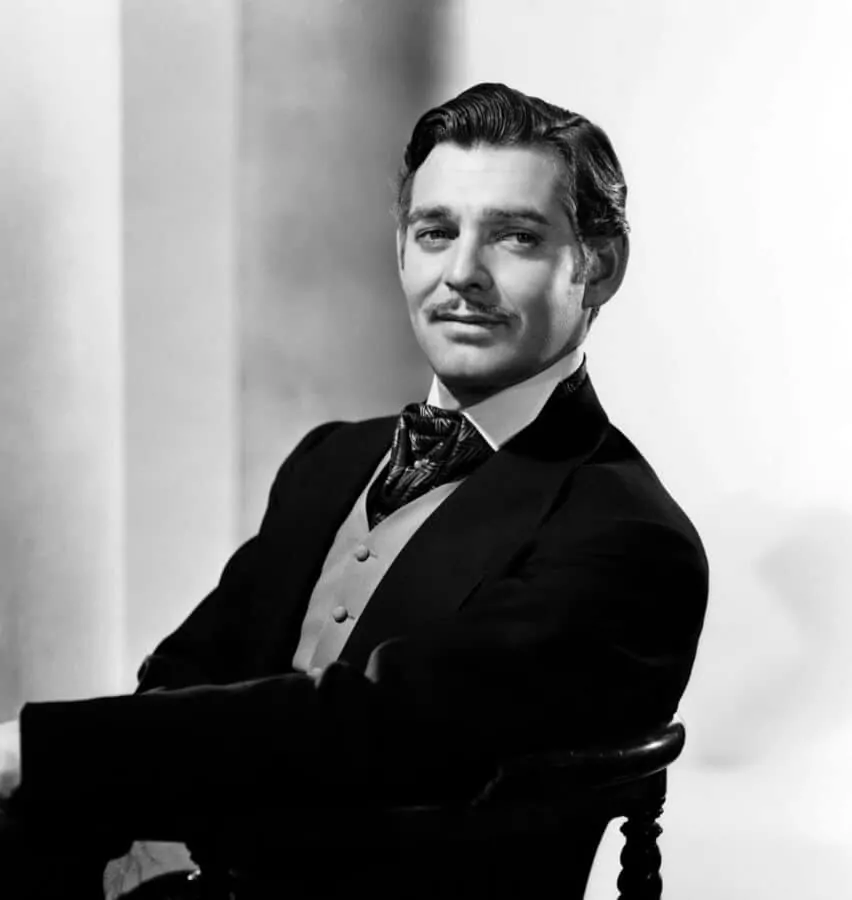
The Beginning of a Career
When he was just 17 years old, Gable had the opportunity to see the play The Bird of Paradise. He was so moved by the performance that he immediately decided acting was in his future and it was something he wanted to do as a career. Despite his interest in theater, he wasn’t able to pursue it until he turned 21 and inherited some money after his beloved stepmother passed away. Opting to move again to Tulsa, his father left and the 21 year old Clark began to find work with some b-listed theater companies which allowed him to move to Oregon. While living in Portland, he made a living selling ties at the Meier & Frank department store as he sidelined in various, random performances. Through his networking, he managed to meet Laura Hope Crews, an actress who recommended he leave his job as a salesman and focus exclusively on a career in acting. This was the beginning of a friendship that would culminate in Crews playing Aunt Pittypat in Gone With the Wind.
Gable took Crews’ suggestion and left his job. He hired an acting coach who happened to also work as a theater manager. The much older Josephine Dillon took him under her wing, paying for him to have his teeth fixed and hair cut. She developed a workout routine and diet to help bulk him up and make him appear more masculine and taught him proper posture. Despite having gone through puberty, Gable had a very feminine and high-pitched voice. Dillon didn’t like this one bit and spent a significant period of time working with Gable to lower his voice and control his unnatural facial expressions. It wasn’t until after a long training period that Dillon allowed Gable to begin looking for work as an actor.
With ongoing financial support from Dillon, Gable ventured forth to Hollywood where Dillon and him fell in love and married. After the wedding, Gable changed his stage name from W.C. Gable to Clark Gable, which he had been called since he was young. Dillon managed to procure him small roles in a number of silent films where Gable worked as an extra, and later a bit player.
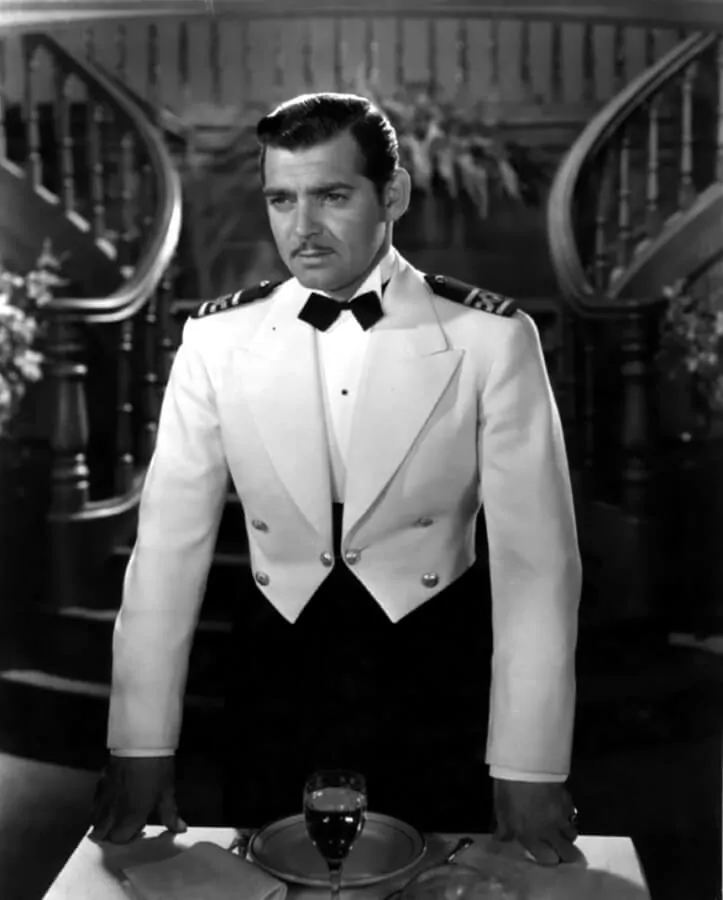
Despite his consistent work as an extra, Gable was unable to actually secure any roles of considerable quality in film and decided to revert back to live theater. In the late 1920s, Gable worked with the Laskin Brothers Stock Company in Houston, Texas, where he acted in a wide range of roles which helped further his experience. In 1929, he left Texas and the couple headed for New York where Dillon found him work on Broadway. However, as the Great Depression commenced and silent films moved into sound pictures, many of the plays Gable was hired for began to close and finding work became difficult for Gable and Dillon.
Returning to Hollywood, Gable was given the role as Killer Mears in the stage production of The Last Mile. Shining in the role, he impressed critics and was offered a contract with MGM for a low budget western called The Painted Desert. Immediately successful in his performance, Gable began to receive a significant amount of fan mail and MGM took notice of their rising star. Women loved his powerful voice and masculine appearance and the love of his fans began separating him from Dillon. In 1930, Gable and Dillon were divorced, only to find Gable remarry just a few days later to a socialite from Texas named Maria Franklin Prentiss Lucas Langham. Moving her to California immediately after the wedding proved difficult as State laws regarding marriage were different and caused them to have to remarry.
Gable continued to gain success and momentum in his career performing as the villain in Night Nurse in 1931. He secured the role when James Cagney suddenly became a leading man after his success in The Public Enemy.
Since he no longer had the support of Dillon, Gable signed on with one of Hollywood’s biggest agents, a woman by the name of Minna Wallas. She managed to connect him back with MGM who was looking for men just like Gable. Working in a variety of supporting roles, the studio began to take further notice of him and increased his role in the film Hell Divers, where he had almost as much screen time as leading man Wallace Beery. MGM began to capitalize on Gable’s strong masculinity and advertised him as a “lumberjack in evening wear”.
Within the same year, his appeal had widened so much so, that Joan Crawford specifically requested him as her co-star in Dance, Fools, Dance. He then shot A Free Soul and from there he was cast as a leading man in every role since. Critics began to love him and The Hollywood Reporter wrote that “a star in the making has been made, one that, to our reckoning, will outdraw ever other star… Never have we seen audiences work themselves into such enthusiasm as when Clark Gable walks on the screen”.
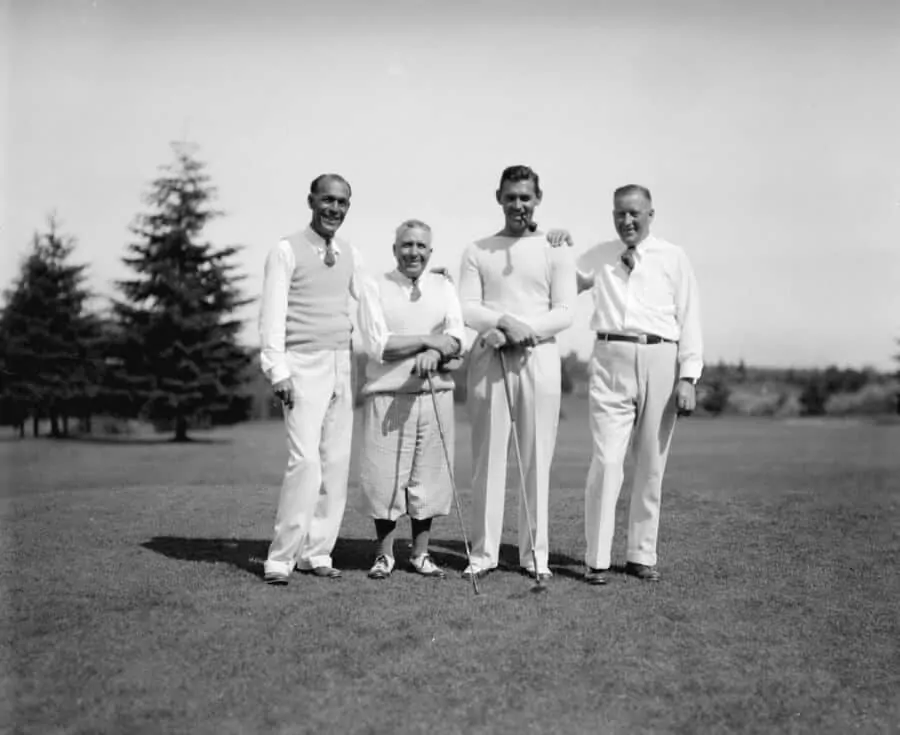
From there, Gable starred in many films making so many in his first year of fame that it made seasoned actors look underworked. Despite being in his second marriage, Gable found himself having an affair with fellow actress Joan Crawford. As a result of the affair and the backlash that resulted, MGM threatened to terminate both of their contracts and black ball them from ever working again. Gable and Crawford separated and, again, despite being married, he shifted his attention and began another affair, this time with Marion Davies.
The following year, Gable was cast in the film Red Dust, opposite of Jean Harlow. Gable, who was unshaven in the film, which was in contrast to his usual dapper appearance, engaged in a very steamy scene for the times with Harlow who appeared braless. His raw and masculine sexuality in that single scene catapulted his career and made him MGM’s number one star. A year later, in 1933, Gable starred again with Harlow in the blockbuster hit Hold Your Man. His performance was so riveting that MGM classified Gable as a perpetual goldmine and recast him and Harlow in two more films. They continued their partnership in four more films until Harlow died during the production of Saratoga in 1937. An obviously distraught Gable, had to continue the shooting of the film as it was only 90% complete when Harlow died. The remaining scenes were filmed using long shots or with body doubles which caused Gable to feel as though he was “in the arms of a ghost”.
A man who had many affairs, Gable had a daughter as the result of an affair he had with actress Loretta Young in 1934. Despite many believing the daughter, Judy, was biologically his, neither of them ever publicly stated that Gable was her father and for a long time, Young contested that she had adopted Judy.
Prior to filming Saratoga, and in the midst of his record-setting career, Gable was offered the role of Peter Warne in It Happened One Night when Robert Montgomery refused it, feeling that the script was poorly written. Despite a tense atmosphere, Gable remained professional and even befriended Frank Capra. The film ended up being such a success that Gable won the Academy Award for Best Actor while the movie won Best Picture. At the time he was on loan to Columbia Pictures and returned to MGM a legend.
Gable was then cast in three pictures with Spencer Tracy making them a team in the eyes of Hollywood. Gable, responsible for Tracy’s success as an actor, was continually partnered every couple of years until Tracy negotiated a star billing clause in his contract which subsequently ended their partnership.
Clark Gable in Striped Suit in Color Faithfully Yours, Clark Gable Autograph
In 1939, after years of making incredibly successful films that he was confident to take part in, Gable was asked to star in the film Gone with the Wind. Reluctant to take on the role, he was nothing if not a consummate professional. Despite his reluctance to be involved, he gave an award winning performance and was nominated again for Best Actor at the Academy Awards. Gone with the Wind would quickly become his lineage and to date, is his most well known performance. Until his death, Gable always said that whenever his career would begin to fade, they would re-release Gone with the Wind and he’d immediately be back on top.
Gable was well regarded for always getting along with his fellow cast members. He was kind and generous, well known for lending a hand or an ear. In 1939, Gable married his third wife, actress Carole Lombard. He was often known for claiming that his marriage to Lombard was his happiest. After marrying, the couple purchased a large ranch in Encino, California and raised a variety of farm animals and pets, living happily until Lombard was killed while traveling as a passenger on Trans-World Airlines Flight 3 when it crashed into a mountain near Las Vegas killing her and the other passengers which included her mother and publicist. Upon hearing the news, Gable flew to the crash site where he had to claim the bodies of his wife, mother-in-law and her publicist, who was a close friend of Gable’s and served as the best man at their wedding. Lombard was declared the first war-related American female casualty of WWII and Gable received a personal letter of condolence from President Roosevelt for his loss.
A month later, Gable returned to work, although it was evident that he was devastated both emotionally and physically. Despite his instability, Gable remained professional and continued to focus on his career. After Lombard’s death, Gable acted in another 27 successful movies and was remarried twice, but according to friends and family was never the same after her tragic passing.
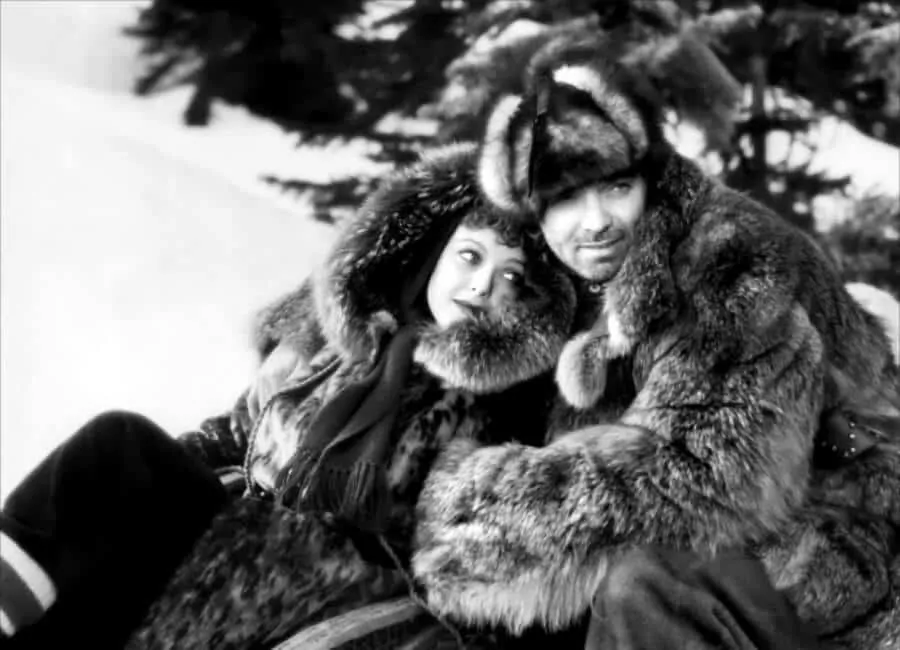
A Military Man
As the war continued after her death, Gable enlisted in the US Army Air Forces in 1942 as a way to pay tribute to his wife, who had suggested before her death that he serve his country. Gable was given a special assignment to make a recruiting film for aerial gunners.
On January 27, 1943, Gable reported to Biggs Army Air Base to train and work as the head of a six-man motion picture unit that would accompany the 351st Bomb Group to England. Spending the majority of the year in England, Gable flew five combat missions, which included one to Germany in which Gable was almost killed when the aircraft was damaged in an attack. When MGM heard the news, they pressured the army to re-assign Gable to noncombat duties. He was awarded the Air Medal and Distinguished Flying Cross for his service. He was discharged upon request in 1944 since he was over-age for combat. His discharge papers were signed by a Captain, later President, Ronald Reagan.
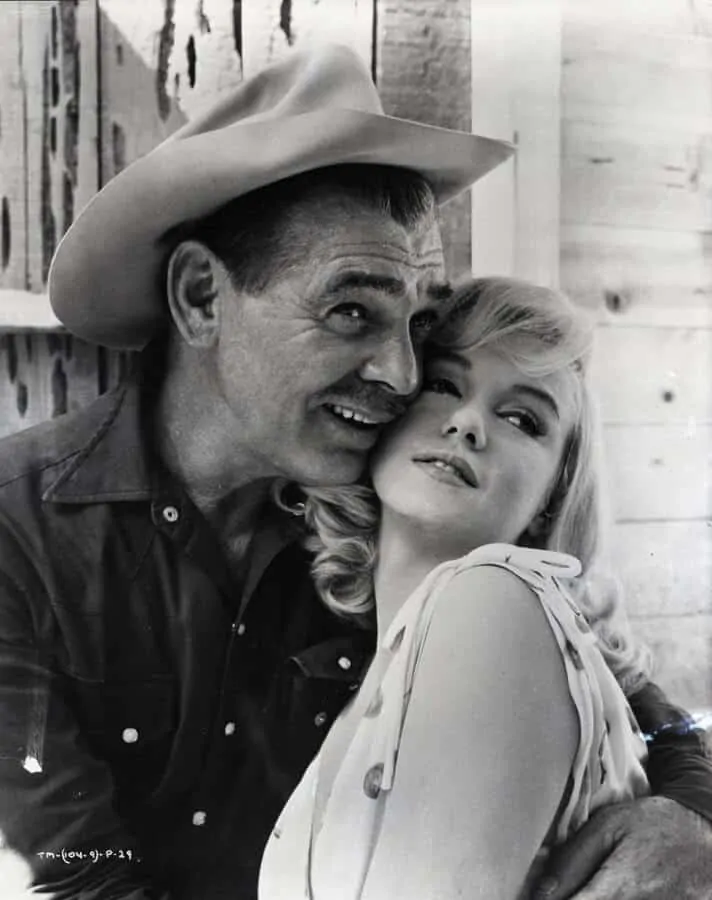
A Return to Hollywood
As soon as he was relieved of duty, Gable went back to his ranch in Encino. He engaged in many relationships and affairs and in 1945 resumed his career with the filming of Adventure which turned into his first failed film. His next film however proved successful and his career was back on track. In 1949, Gable got married again, this time to a woman named Sylvia Ashley from Britain. The marriage was short and turbulent to say the least and they were divorced in 1952. Gable began to have affairs again, one of which was with the very young Grace Kelly, who at the time was young enough to be his daughter. By now, Gable was largely considered to be unhappy. He was lonely and felt that MGM was giving him roles that were beneath him. In 1953, Gable opted not to renew his contract with MGM and he began working independently. In 1955, in the midst of his suffering career, Gable remarried for a fifth time, this time to fashion model Kay Spreckles. Gable became the stepfather to her son Bunker who tragically died in 1977 after amassing quite the reputation as a notorious celebrity child throughout much of the 1960s and ‘70s.
The same year he was married, Gable started his own production company. Despite the new incorporation, he only managed to produce The King and Four Queens before his health began failing. In 1957, Gable went back to filming and took the leading role in Band of Angels which proved to be a complete failure both critically and commercially. Newsweek said, “here is a movie so bad that it must be seen to be disbelieved.”
The next project was Teacher’s Pet which he shot the following year. However, Gable was getting older and was now overweight. To counter his failing appearance, they shot the movie in black and white in an attempt to hide his elder appearance in hopes he would still look youthful and muscular. The film wasn’t exactly successful, but it was good enough that Gable was offered roles in subsequent films including Run Silent, Run Deep. It was evident to the studios that Gable was getting older and his career was long gone. Gable began to receive TV offers but refused them as soon as they came in. Now almost 60, Gable took on two light hearted films for Paramount, with It Started in Naples being nominated for an Academy Award and two Golden Globes.
Ten days after suffering a massive heart attack, Gable passed away from a coronary thrombosis at Hollywood Presbyterian Hospital on November 16, 1960. He was interred in The Great Mausoleum at Forest Lawn Memorial Park in Glendale, California next to his third wife, Carole Lombard.
Four months later, his wife Kay gave birth to a son named John Clark Gable.
In 1961, Gable’s final film, The Misfits was released. Acting alongside Marilyn Monroe, it is today considered by many to be his finest performance.
Clark Gable with Dalmatian and high rise trousers CG playing golf in style
The Style of Clark Gable – A Well Dressed Gentleman
by Sven Raphael Schneider
Clark Gable was a well dressed gentleman on and off the screen. Though you must know that back in the day, it was normal for actors to wear their own wardrobe on set. Today, that would be almost unthinkable or at least most actors would look horrible. He was a friend of animals, loved to hunt, and played polo. As such he was a big fan of casual clothing, yet he always looked so elegant when wearing it.
Interestingly, he was close to another silver screen legend that we discussed before: Cary Grant
They not only shared the same initials CG but they also had a similar taste in clothes and rumor has it that they even exchanged clothing items at times since they had both the same height and built!
Gable will always be remembered for his iconic looks from the 1930’s with his double breasted suits, wide lapels, broad shoulders, drape cut and trim waist even though he changed his style somewhat during his more seasoned years. One thing he did not change was his signature mustache, which he pulled off well until the very end.
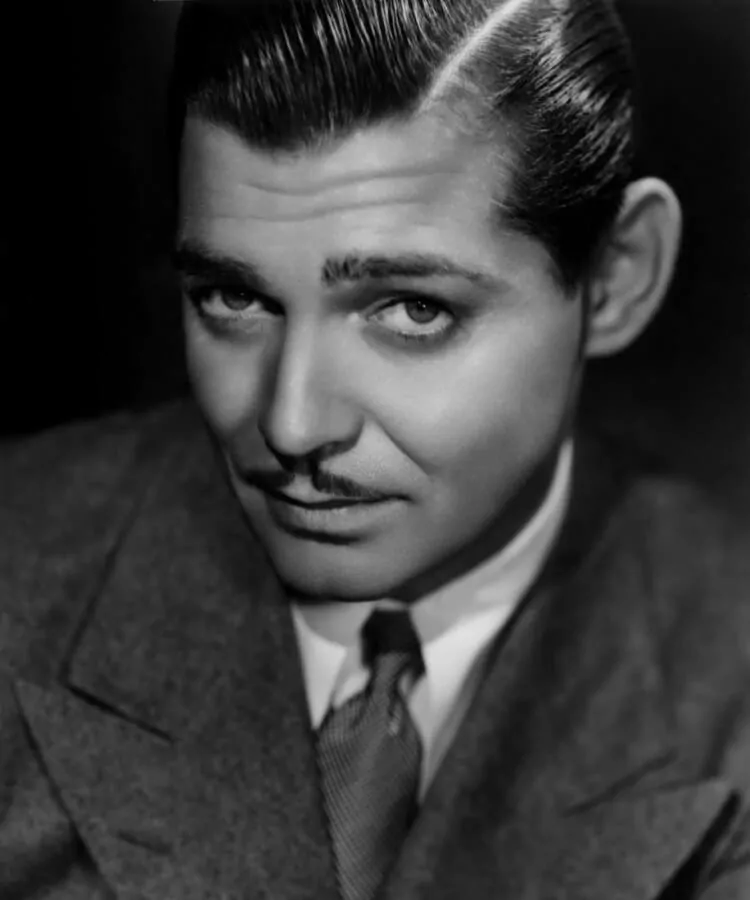
Clark Gable & The Undershirt
Many claim to this day that Clark Gable was single-handedly responsible for the decline of the undershirt. As outlined before, I am not a great fan of the undershirt, and neither was Gable, but then the film It Happened One Night aired for the first time in 1934 there was a scene where Gable took off his sweater and then his shirt, exposing that we wore no undershirt. Apparently this one scene was enough to discourage American men from wearing undershirts anymore so that sales for undershirts decrease by 40% overnight, and some claim even a higher loss.
In my opinion, it is questionable whether this theory is in fact true but rather than to bore you with the details of this urban legend, I suggest you read on here if you would like to learn more about this subject.
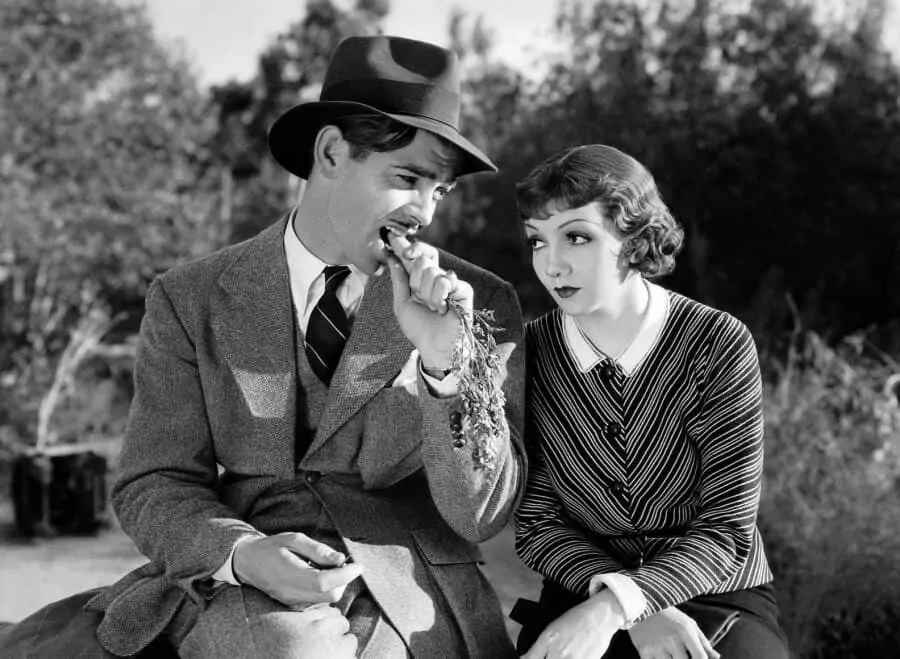
Why Clark Gable Is A Style Icon
Many will reference the movie Gone with the Wind as the reason Clark Gable became a style icon, and while the incarnation of Southern opportunist Rhett Butler was arguably Gable’s most famous role, the attire was not the reason he became know as a style icon.
Instead the suits, tuxedos, and tailcoats he wore in other movies made him the style arbiter he became. Even the 1953 movie Mogambo, which portrayed Gable’s character in a colonial Safari setting made him look like someone who is always adequately dressed, no matter the circumstances. Mastering the art of being well dressed always means to adapt to your surroundings without losing the character of your personal style, and Gable did that well.
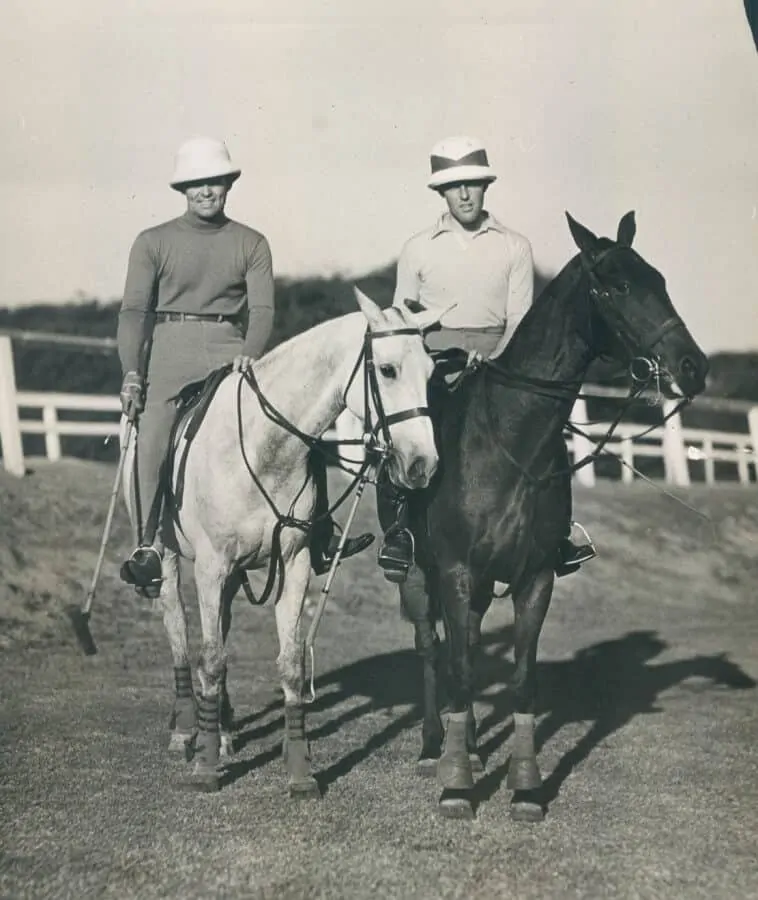
To me, he was also a style icon because no matter what he wore, he always did it in a slightly rakish way that set him apart from the crowd. For example just take a look at this picture of him riding a polo horse. He could have worn his hat just like the guy on the right but instead he tilted it slightly to the side making him look infinitely more elegant.
Dress The Gable Way
Ideally, you want to get inspired by certain elements of Gables wardrobes rather than copying his entire outfits. The following list contains 14 things that helped Gable establish his hallmark style. I am sure you will find something that can help you improve your’s!
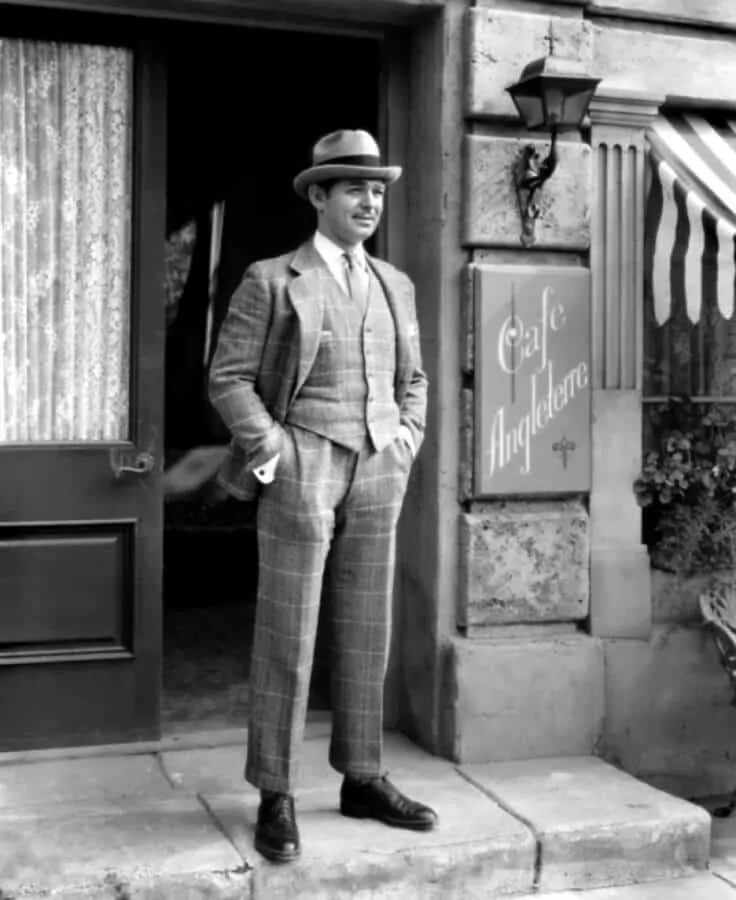
1. High Rise Slacks with Pleats
Gable wore high rise trousers – always. When he got older, his slacks became a bit trimmer but he always kept the high rise and pleats.
2. Button Down Collar with Ties
Gable wore button down collar shirts with ties. Personally, I am not a huge fan of the look unless the collar works perfectly with it, but if you go for a Clark Gable look, pair it with a madder silk or micropattern tie and white or off white shirt with an interesting sport coat.
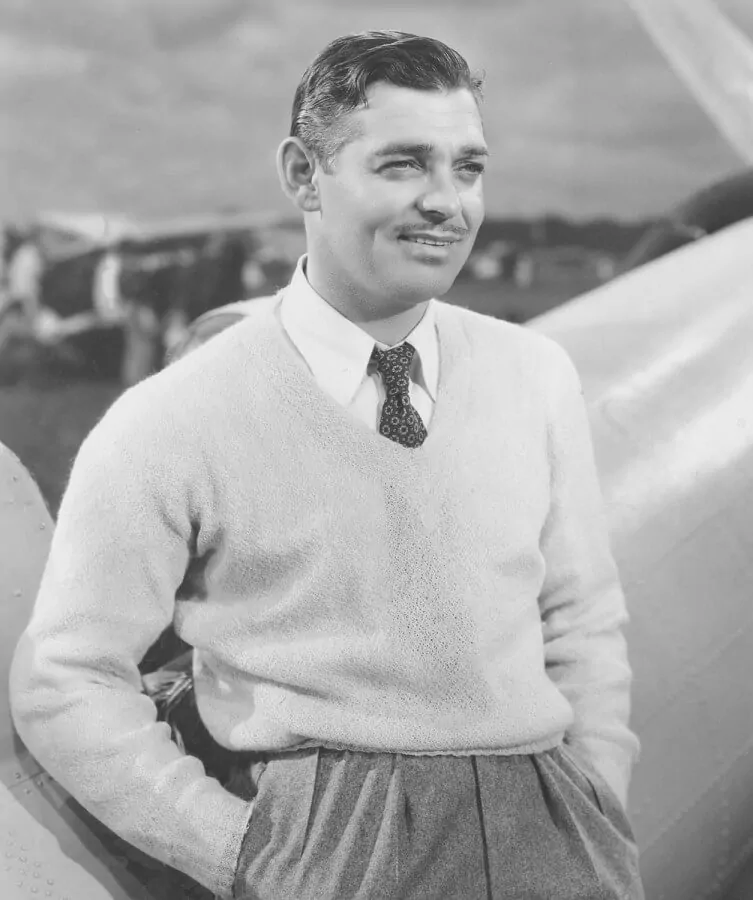
3. V-Neck Sweaters with shirt and tie
Gable liked to wear sweaters with a deep V necks that would show off his tie. So next time you buy a sweater, look for a V-neck.
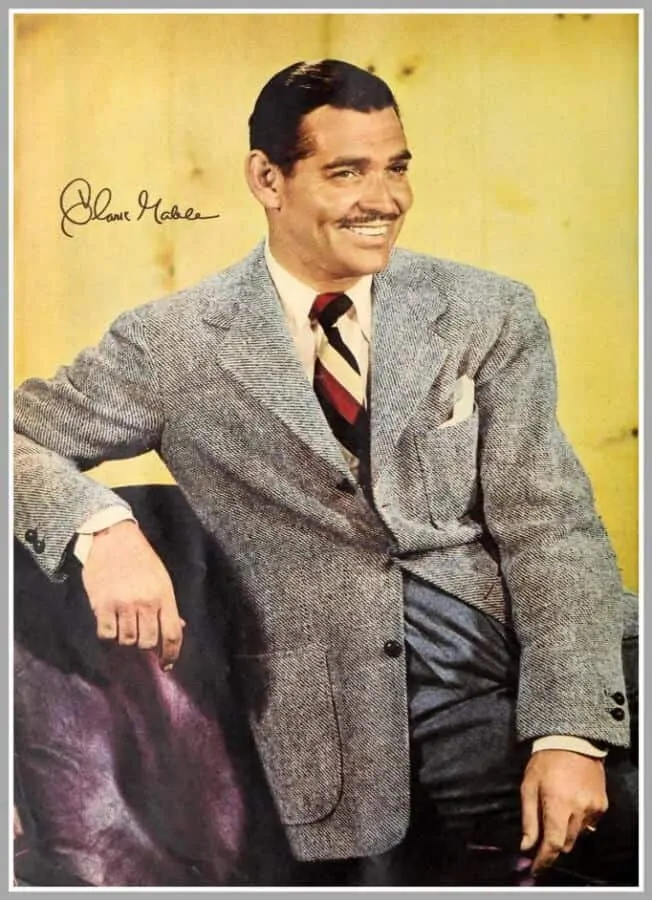
4. Patch Pockets
Gable liked his single breasted sport coats with patch pockets. He famously wore a sport coat with 3 patch pockets and he would continue to do so for years to come.
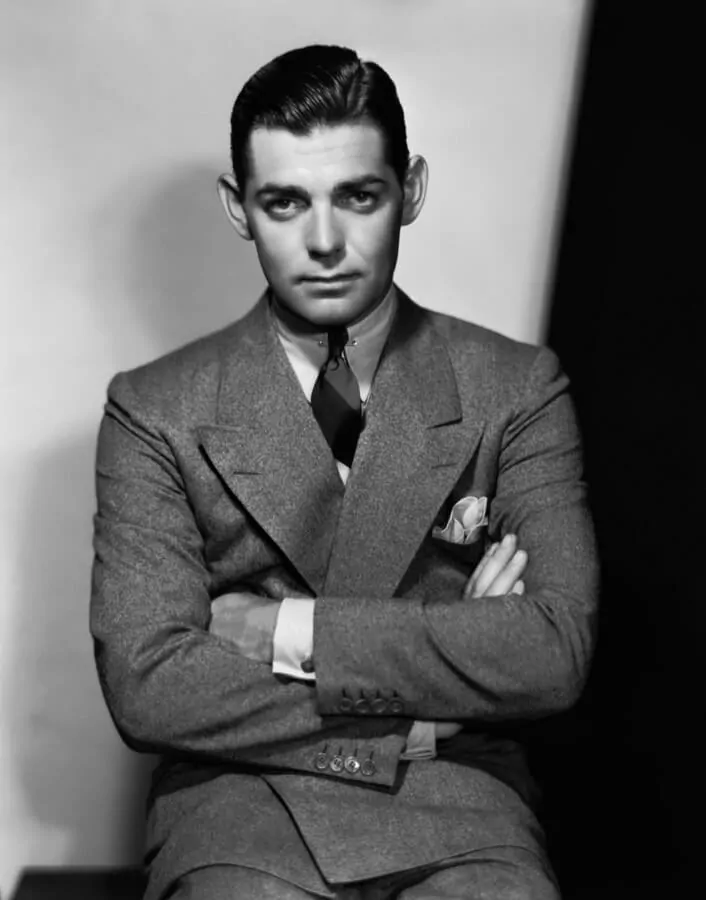
5. Wide Lapels
Especially his double breasted suits had wide lapels with a decent, rounded belly. Even his single breasted jackets had sometime what seem to be 4″ / 10cm lapels.
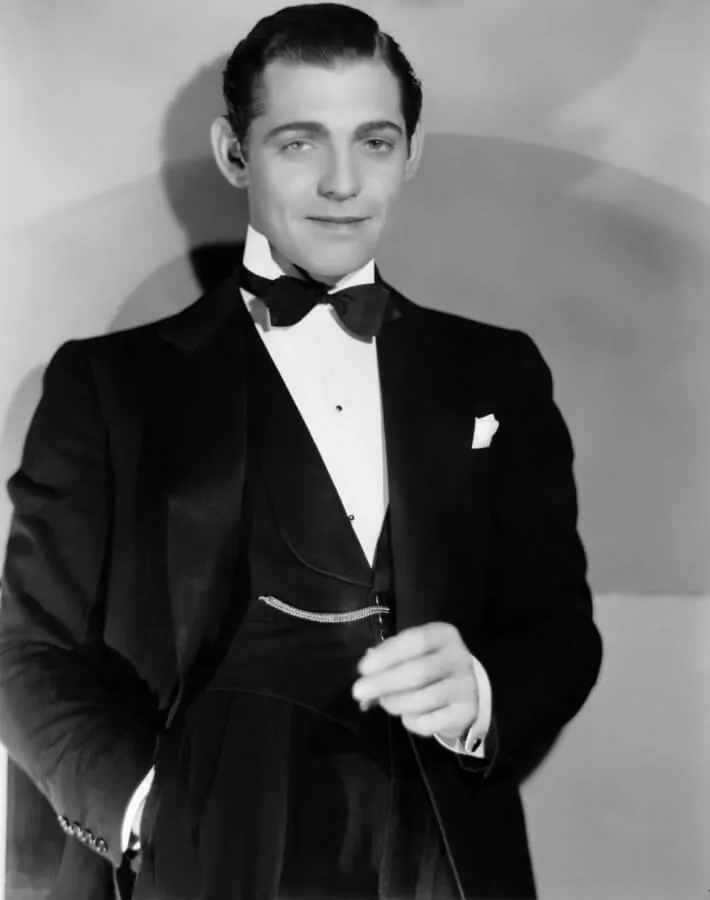
6. Three piece Suits
Gable was a big fan of 3 piece suits, not matter whether it was a worsted or flannel.
7. Classic Shirt Collars
Gable never wore a cutaway collar shirt, but much rather classic collars which worked well with this face shape. That being said, his collars pretty much work with any type of face.
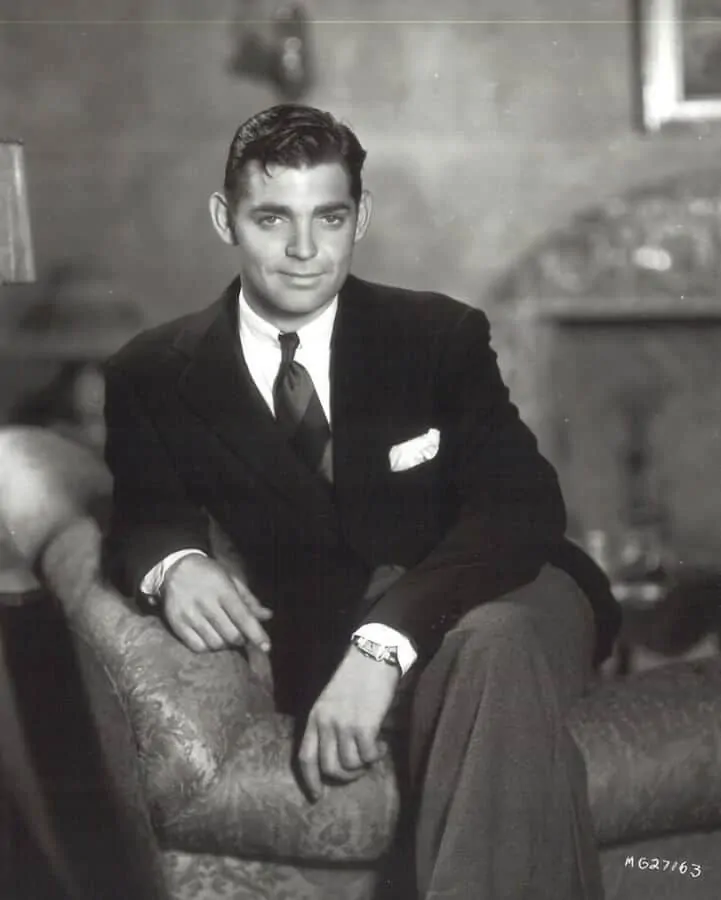
8. Collar Pins
Gable was a huge fan of safety collar pins
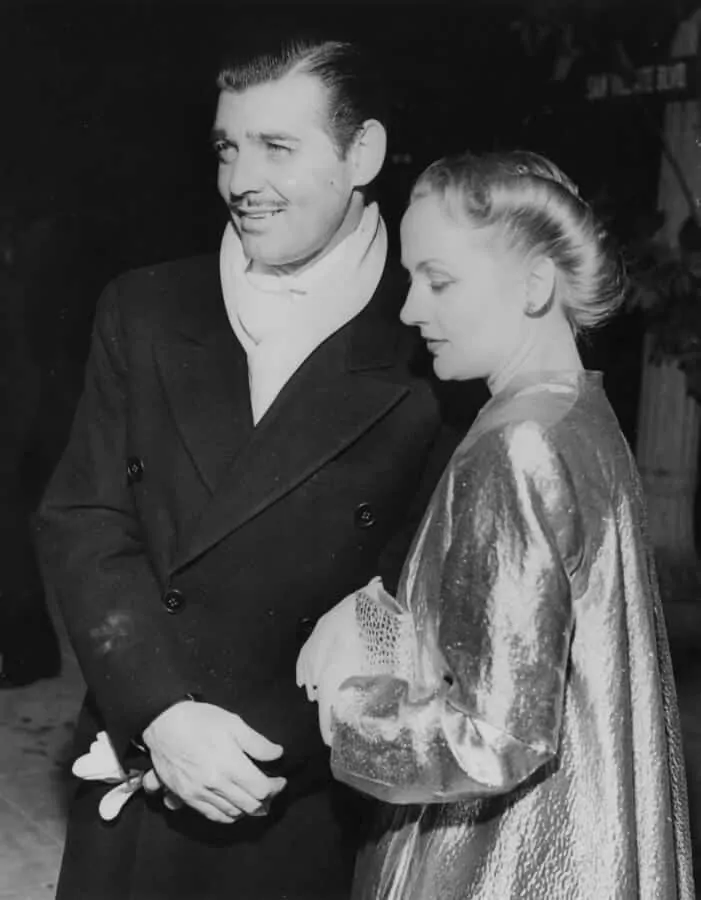
9. Double Breasted coats and overcoats with overlap
Gables DB suits and overcoats had a generous amount of overlap, which is something you will not find anymore today, unless you specifically request it with a bespoke garment.
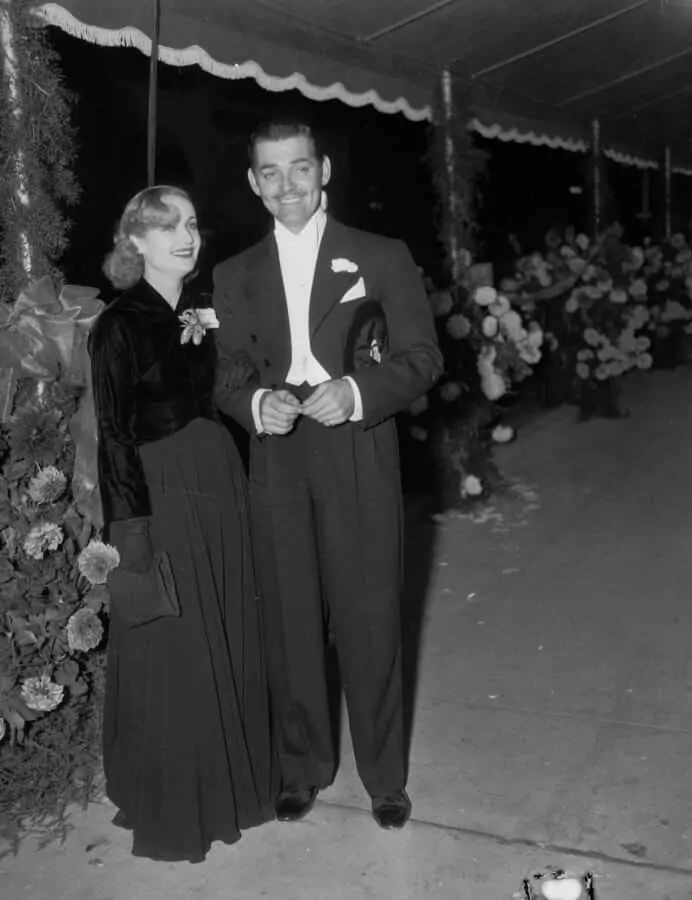
10. Pocket Squares
Gable was a fan of pockets squares – either plain white with a crown fold or printed squares in various colors – he wore them all.
11. Boutonniere with Evening Wear – always
Whenever we wore evening outfits, Gable wore a boutonniere. His favorites were carnations and roses. He even wore lapel flowers with much more casual outfits and combinations whenever he could.
12. Pinky Ring
Gable wore his pinky rings almost exclusively on his left hand, though pictures exist showing him wearing it on the right hand.
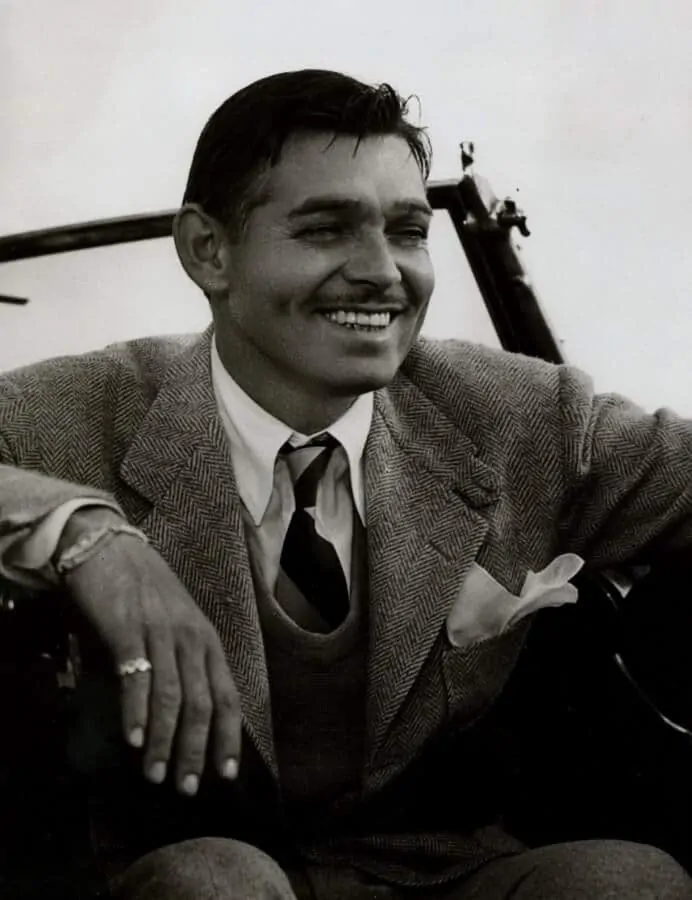
13. Pomade
Pomade was a staple for Clark Gable. Checkout our Pomade Guide to learn about the pros and cons of using this rather inexpensive hair product.
14. Mustache
Last but not least, nothing will indicate Clark Gable as much as his signature pencil mustache. Whether you can pull it off or not, I don’t know and when you wear it people may think you want to copy Gable, which is never something you want to evoke, after all you have your own style and that’s what you want to wear. Personally, I would not wear his mustache, unless of course it was Halloween or maybe for November.
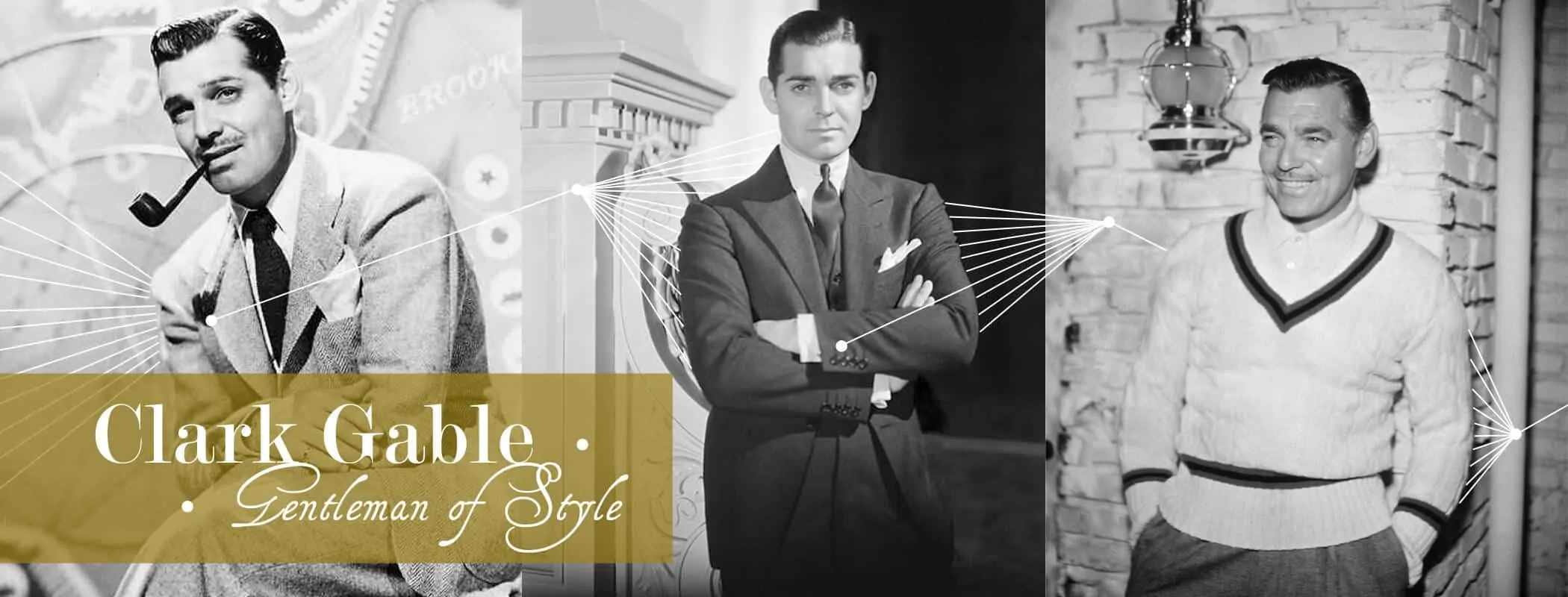
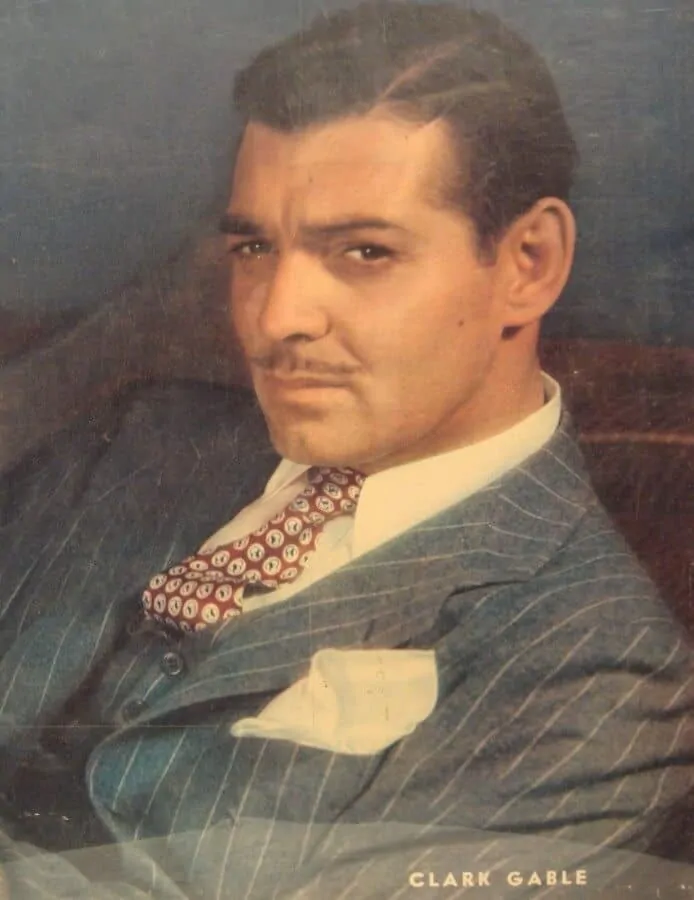
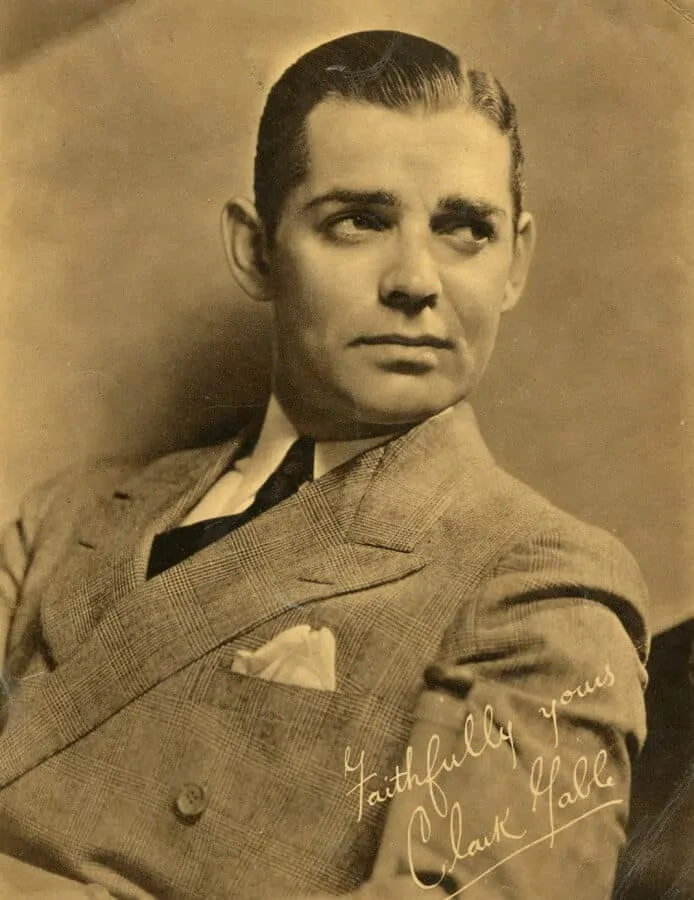

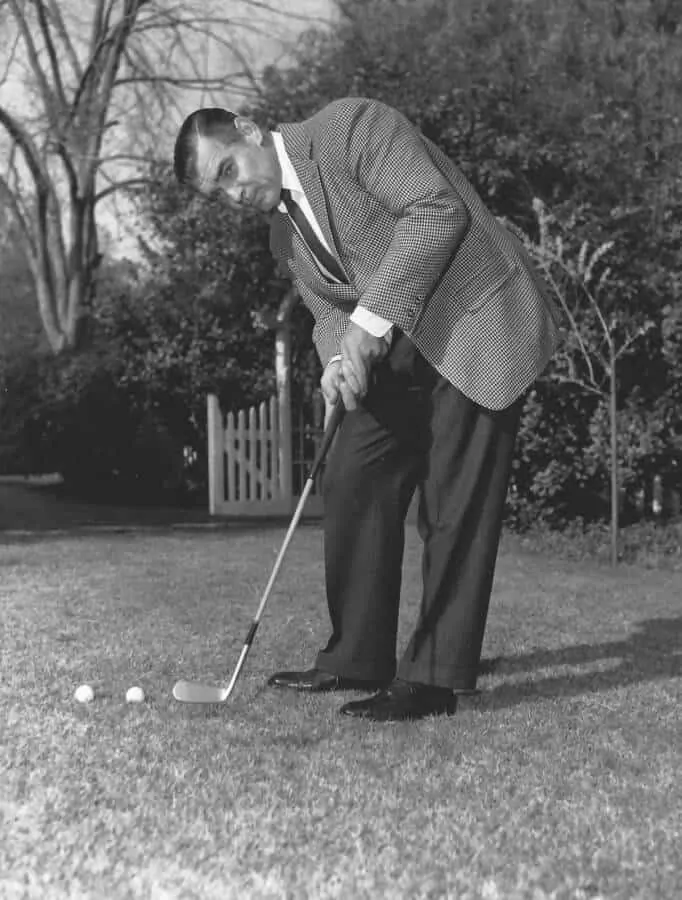
Rich and inspiring article, thanks J.A. and Sven.
Great article. Bit of trivia: Clark Gable’s birth certificate said he was born a girl. Certainly nothing girlish about his style.
No way… it said he was born female? Accidental I’m guessing? This guy had style and some to spare. Though so did a lot of actors during that same time period. I doubt style will ever be quite as well put together as it was then.
Sven/A.J.
Where did you get the picture of Gable and the dog? I need to get a copy!
Andre
J.A.
The dog is not a dalmatian, it is a Llewellin Setter. A breed that is cousin to the English Setter – great bird hunting dog.